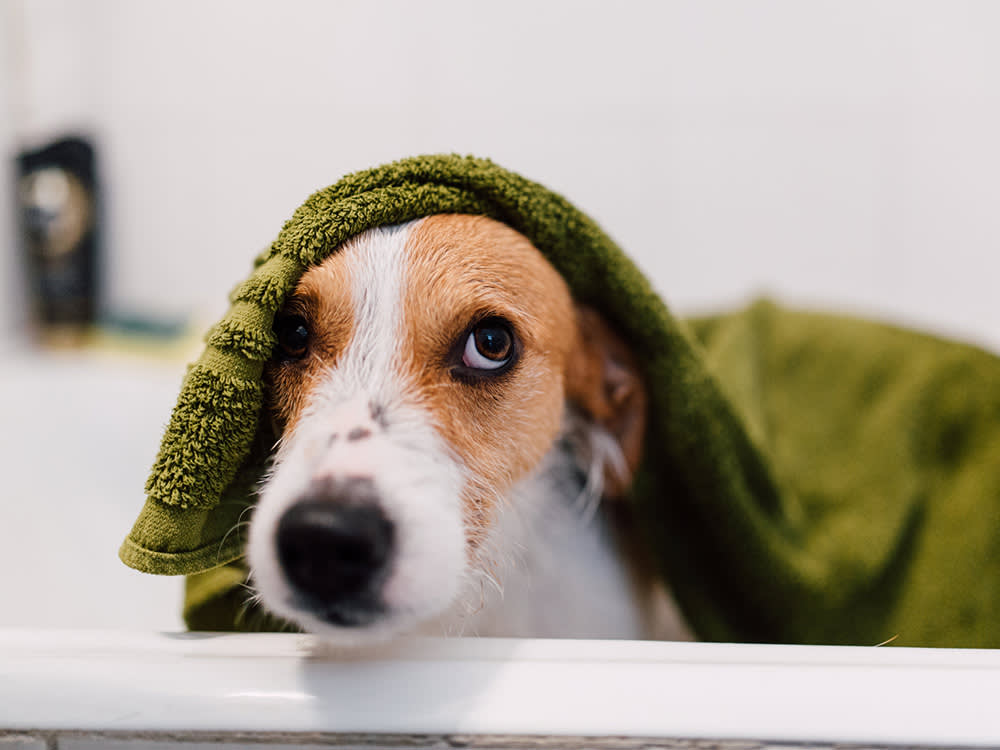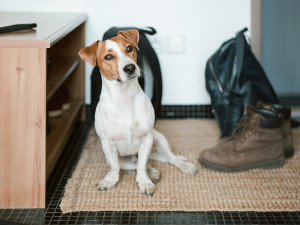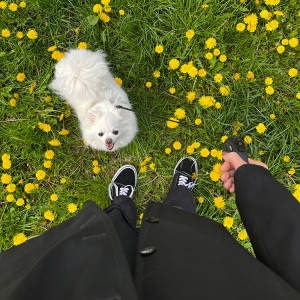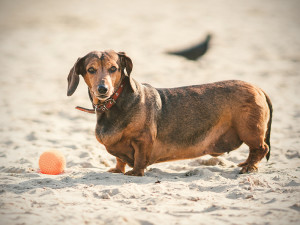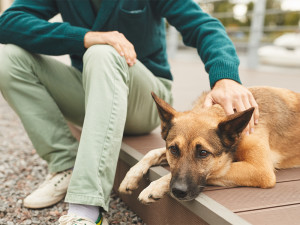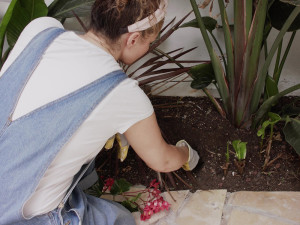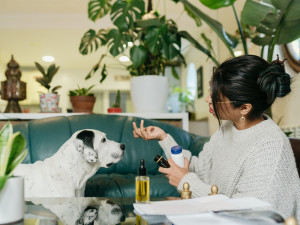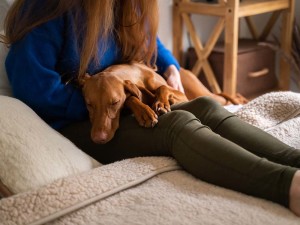How to Express Dog Anal Glands Safely and Effectively at Home
Yeah, it’s super gross — but your pup will thank you.
Part of having a dog means getting used to thinking about butt stuff. Are they pooping normally? Is their poop runny? Are they straining to poop? Can they poop out that weird thing they ate? Why are they sniffing other dog’s butt’s? Why are they scooting their butt on my brand new Scandi-inspired rug? What is that fishy smell? If you find yourself asking those last two questions, read on to get familiar with dog anal glands.
What are dog anal glands?
Many people use the terms anal sacs and anal glands interchangeably (and we will, too). Anal glands, which are actually anal sacs, are two small sacs under the skin near the anus. They sit at approximately the four o’clock and eight o’clock positions on each side of the anus. These anal sacs are full of anal glands that produce a brown, oily, fishy smelling discharge.
Anal glands will periodically fill with this stinky fluid. When a dog poops, the stool applies pressure on the way out, releasing the anal glands. Normally, anal glands are emptied without any conscious effort from you or your dog. Sometimes dogs will empty their anal glands in times of stress or fear. Your local veterinary staff knows about this possibility all too well.
Although emptying these glands should be automatic, some dogs’ anal glands just don’t drain, even if they’re pooping normally. Dogs can also have difficulty expressing their anal glands if the anal glands become overly full, impacted, or infected. These dogs need a little assistance.
How much do you spend on your pet per year?
Why would I need to express my dog’s anal glands at home?
Most pet parents don’t need to get involved with their dog’s anal glands (and really shouldn’t want to). But if your dog’s anal glands don’t empty as they should and your vet has ruled out other issues, you may want to learn to express them at home.
For some pet parents, this task is only performed when their dog is showing signs of discomfort like scooting or excessive licking. For dogs with chronic issues, expressing anal glands can become a routine part of grooming. Either way, proper technique can help things go smoothly and save the hassle of unnecessary mess and discomfort. Having a veterinary staff member guide you through the first attempt is a good idea when learning how to express a dog’s anal glands.
Though anal gland expression can be performed at home, some anal gland issues need veterinary attention. If an anal gland is noticeably swollen, the skin over the gland is broken, an anal gland is leaking, or if the gland is firm and cannot be expressed, you should seek veterinary attention. These can be signs of an anal gland infection, ruptured anal gland abscess, or a tumor.
How can I express my dog’s anal glands at home?
When expressing a dog’s anal glands at home, it’s best to come prepared and have all of your supplies handy. Some dogs won’t put up a fuss, but others will let you know that this is not their favorite activity, so it’s best to have a buddy. If your dog is absolutely not having it, or if your dog seems uncharacteristically painful, abort mission and contact a professional.
There are two methods to express dog anal glands — external and internal. Pick the one that is most comfortable for you and your dog.
How to express dog anal glands externally
Gather your supplies: Gloves and paper towels.
Position your dog: Have someone help you if possible. Stand behind your dog and lift their tail.
Locate the anal glands: With a gloved hand and a paper towel, gently grab the area of the rectum, extending about an inch on either side of the anus. You should feel the thicker muscle of the sphincter along with the anal glands, which may feel like firmer lumps on either side.
Express the anal glands: Use your thumb and index finger to gently squeeze the anal glands together until a small amount of brown fluid comes out. This may need to be repeated if both glands are full.
Clean up: Use paper towels to wipe away any fluid that came out. If needed, use a warm washcloth to clean any discharge from your dog’s fur. Dispose of the gloves and wash your hands thoroughly.
Reward your dog: Give your dog praise and treats for their cooperation.
How to express dog anal glands internally
Gather your supplies: Gloves, paper towels, and lubricant (like Vaseline or KY Jelly).
Position your dog: Have someone help you if possible. Stand behind your dog and lift their tail.
Locate the anal glands: With a gloved, lubricated finger, gently insert your index finger about an inch into your dog’s rectum and locate the anal glands. The anal glands are located on either side of the anus (remember: four and eight o’clock) and may be the size of a pea or a grape depending on fullness.
Express the anal glands: Using a paper towel as cover, gently squeeze the anal glands between your thumb (which remains outside of your dog’s butt) and index finger until a small amount of brown fluid comes out. If you do not see any fluid, the gland may already be empty.
Repeat on the other side.
Clean up: Use paper towels to wipe away any fluid that came out. If needed, use a warm washcloth to clean any discharge from your dog's fur. Dispose of the gloves and wash your hands thoroughly.
Reward your dog: Give your dog praise and treats for their cooperation.
How can I tell if my dog’s anal glands need to be expressed?
Signs that your dog is experiencing issues with their anal glands include:
Scooting
This is the most common sign of anal gland problems. If your dog is scooting their butt across the floor, they may be trying to relieve pressure from their anal glands.
Excessive Licking
If your dog is licking under their tail excessively, it could be a sign that their anal glands are full or infected.
Staining/Leaking
Leaky anal glands can stain fur or bedding. It’s usually dark brown and has a strong, fishy odor.
Discomfort When Defecating
A few things can cause a dog to strain while defecating, and anal gland irritation is one of them.
How often should I express my dog’s anal glands?
Dogs that are known to develop issues without routine assistance should have their anal glands expressed every three to four weeks. But most dogs don’t need any intervention when it comes to their anal glands.
Are there any preventive measures to avoid anal gland issues in dogs?
Dog parents can take a few preventative measures to try to help avoid anal gland issues in their dogs.
Make sure your dog is getting plenty of fiber: Fiber helps to keep stool firm and bulky, making it more likely that your dog will express their anal glands naturally,
Avoid feeding table scraps: Inappropriate treats can lead to loose stool, which can make it more difficult for your dog to express their anal glands.
Keep your dog at a healthy weight: Overweight dogs are more likely to have anal gland issues. Make sure your dog is getting plenty of exercise and gets proper nutrition.
Stay on top of it: Anal gland impaction can progress to an anal gland infection. If your dog is showing signs of anal gland problems, take them to a vet. If needed, make expressing your dog’s anal glands a part of their grooming schedule.
It is important to note that most dogs do not need their anal glands expressed. In these cases, let nature take its course and keep your fingers out of your dog’s butt. But, if your dog is showing signs of anal gland issues, they may appreciate the help (after the fact).
FAQs (People Also Ask):
Why would I need to express my dog’s anal glands at home
If your dog’s anal glands don’t empty as they should, you may need to learn how to express them at home.
How can I express my dog’s anal glands at home
Dog anal glands can be expressed internally or externally by gently squeezing each anal sac. This is best done with someone to help restrain your dog.
How can I tell if my dog’s anal glands need to be expressed
A dog with full or impacted anal glands will scoot their butt on the floor, lick their hind end, or strain when pooping.
What should I do if I’m uncomfortable expressing my dog’s anal glands or if my dog shows signs of infection?
Anal gland expression can be performed by a staff member at a vet clinic or an experienced groomer. Dogs with signs of anal gland infections should see a vet.
How often should I express my dog’s anal glands
Most dogs don’t need their anal glands expressed. Dogs who need their anal glands expressed routinely should have it done every three to four weeks.
Are there any preventive measures to avoid anal gland issues in dogs
You can help avoid anal gland issues by keeping your dog at a healthy weight, making sure they get plenty of fiber, and avoiding table food that may cause diarrhea.
Is it normal for my dog to be reluctant or resistant during anal gland expression?
It should not hurt a dog to express anal glands, but it can be uncomfortable. If your dog is in pain or won’t allow anal gland expression at home, contact your vet.
